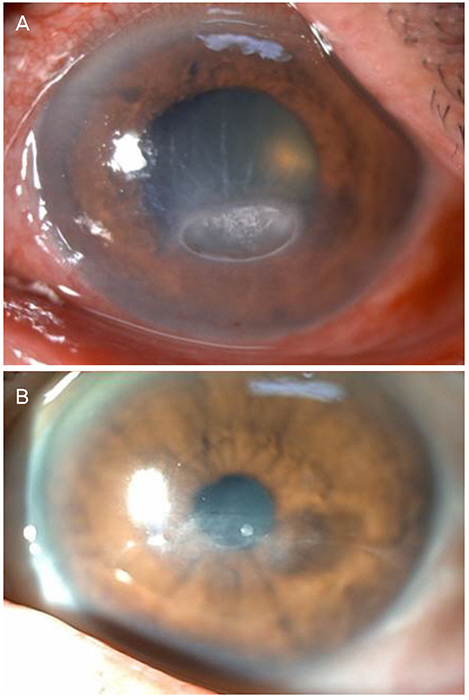J Korean Ophthalmol Soc.
2019 Aug;60(8):787-791. 10.3341/jkos.2019.60.8.787.
Infectious Keratitis Caused by Shewanella Putrefaciens
- Affiliations
-
- 1Department of Ophthalmology, Chonnam National University Medical School, Gwangju, Korea. kcyoon@jnu.ac.kr
- KMID: 2455462
- DOI: http://doi.org/10.3341/jkos.2019.60.8.787
Abstract
- PURPOSE
We report a case of infectious keratitis caused by Shewanella putrefaciens in a patient after fishing.
CASE SUMMARY
A 75-year-old male with no underlying disease other than hypertension was admitted to our hospital because of decreased visual acuity and congestion in his left eye for 2 weeks. At the first ophthalmic examination, the best-corrected visual acuity (BCVA) of the left eye was counting fingers. Slit lamp examination showed stromal infiltrates with 2.0 × 2.0 mm corneal epithelial defects, endothelial inflammatory plaques and 1 mm height hypopyon with severe inflammation in the anterior chamber. Bacterial culture tests were performed by corneal scraping, which were positive for Shewanella putrefaciens, followed by treatment with moxifloxacin and ceftazidime topical antibiotics. After 2 months of treatment, the BCVA of the left eye improved to 0.4 and the corneal lesion clinically improved with residual mild stromal opacity.
CONCLUSIONS
Shewanella putrefaciens should be considered as a causal pathogen of infectious keratitis in patients after fishing. We report a case of infectious keratitis caused by Shewanella putrefaciens, which has never previously been reported in the Republic of Korea.
Keyword
MeSH Terms
Figure
Reference
-
1. Janda JM. Shewanella: a marine pathogen as an emerging cause of human disease. Clin Microbiol Newsl. 2014; 36:25–29.
Article2. Vignier N, Barreau M, Olive C, et al. Human infection with Shewanella putrefaciens and S. algae: report of 16 cases in Martinique and review of the literature. Am J Trop Med Hyg. 2013; 89:151–156.
Article3. To KK, Wong SS, Cheng VC, et al. Epidemiology and clinical features of Shewanella infection over an eight-year period. Scand J Infect Dis. 2010; 42:757–762.
Article4. Tsai MS, You HL, Tang YF, Liu JW. Shewanella soft tissue infection: case report and literature review. Int J Infect Dis. 2008; 12:e119–e124.
Article5. Mohan N, Sharma S, Padhi TR, et al. Traumatic endophthalmitis caused by Shewanella putrefaciens associated with an open globe fishhook injury. Eye (Lond). 2014; 28:235.
Article6. Park HJ, Tuli SS, Downer DM, et al. Shewanella putrefaciens keratitis in the lamellar bed 6 years after LASIK. J Refract Surg. 2007; 23:830–832.
Article7. Holt HM, Søgaard P, Gahrn-Hansen B. Ear infections with Shewanella alga: a bacteriologic, clinical and epidemiologic study of 67 cases. Clin Microbiol Infect. 1997; 3:329–334.
Article8. Holt HM, Gahrn-Hansen B, Bruun B. Shewanella alga and Shewanella putrefaciens: clinical and microbiological characteristics. Clin Microbiol Infect. 2005; 11:347–352.9. Khashe S, Janda JM. Biochemical and pathogenic properties of Shewanella alga and Shewanella putrefaciens. J Clin Microbiol. 1998; 36:783–787.10. Oh SY, Lee SJ, Park JM. A case of endophthalmitis caused by Shewanella algae after trauma. J Korean Ophthalmol Soc. 2013; 54:365–369.11. Bravenec CA, Pandit RT, Beaver HA. Shewanella algae keratitis. Indian J Ophthalmol. 2019; 67:148–150.
Article12. Holt HM, Gahrn-Hansen B, Bruun B. Shewanella species: infections in Denmark and phenotypic characterisation. Clin Microbiol Infect. 2004; 10:348–349.13. Héritier C, Poirel L, Nordmann P. Genetic and biochemical characterization of a chromosome-encoded carbapenem-hydrolyzing ambler class D beta-lactamase from Shewanella algae. Antimicrob Agents Chemother. 2004; 48:1670–1675.14. Willcox MD. Pseudomonas aeruginosa infection and inflammation during contact lens wear: a review. Optom Vis Sci. 2007; 84:273–278.
Article15. Massey EL, Weston BC. Vibrio vulnificus corneal ulcer: rapid resolution of a virulent pathogen. Cornea. 2000; 19:108–109.
Article
- Full Text Links
- Actions
-
Cited
- CITED
-
- Close
- Share
- Similar articles
-
- A Case of Spontaneous Bacterial Peritonitis with Bacteremia Caused by Shewanella algae
- Infectious Keratitis Caused by Eikenella corrodens
- A Case of Endophthalmitis Caused by Shewanella algae after Trauma
- Tenosynovitis on Finger in Children due to Shewanella algae
- Epidemiology of Contact Lens Related Infectious Keratitis(1995.4 ~1997.9): Multi-center Study




